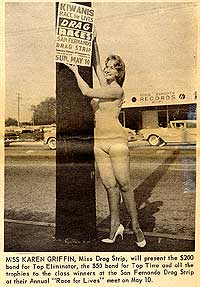|

Promoting Drag Races with Posters
and Telephone Poles
12/8/05
 ll of the corporatespeak at the front of my latest National
Dragster got me thinking about how the business of drag
racing has changed in my professional lifetime. Even before
getting to editor Phil Burgess’s excellent editorial
(about Pomona’s all-supercharged Comp finale, NHRA’s
first since 1973), his poor readers were assaulted by two
Page Four “news items” announcing organizational
sponsorships (e.g., the clumsy renaming of “Historic
Auto Club Raceway at Pomona”) and multiple personnel
moves within the ever-growing sales and marketing teams.
ll of the corporatespeak at the front of my latest National
Dragster got me thinking about how the business of drag
racing has changed in my professional lifetime. Even before
getting to editor Phil Burgess’s excellent editorial
(about Pomona’s all-supercharged Comp finale, NHRA’s
first since 1973), his poor readers were assaulted by two
Page Four “news items” announcing organizational
sponsorships (e.g., the clumsy renaming of “Historic
Auto Club Raceway at Pomona”) and multiple personnel
moves within the ever-growing sales and marketing teams.
This
former editor suspects that no National Dragster
staffer dared edit what amounted to press releases issued
by the marketing department that now runs this organization.
Dig the lingo: “naming rights”; “presenting
sponsorship”; “track entitlement”; “signage
rights”; “sponsor activation”; “series
entitlement”; “contractual elements”; “potential
activation opportunities.”
Am I the only NHRA member who wonders why such drivel is
directed at us? Is anyone else disturbed by the absence of
motorsports experience among these strangers being hired or
promoted?
Please, no hate mail educating your naive columnist about
how drag racing runs on deals and promotion. Prior to starting
a motorsports advertising agency (Good Communications Inc.;
www.goodcomms.com), yours truly handled publicity for both
Orange county International Raceway (1973-75) and Lions Drag
Strip (1968-69). Even earlier, this preteen kid would strain
to overhear fascinating promotional discussions on the other
side of the plywood wall that separated my dad’s trophy
shack from the tiny office of San Fernando Raceway.

Lifted from Drag News (May 2,
1959) |
In those prehistoric days before television advertising and
computers, word seemed to get around just as quickly and efficiently
as it does today, only less expensively. Most tracks drew
profitable turnouts of racers and fans on a weekly basis,
despite little or no paid promotion. Spectators tended to
support their nearest drag strip. Bringing in more butts to
pay for some special show (e.g., a best-of-three match race
for a spot on the prestigious Mr. Eliminator List) was a simple
matter of printing up posters, then nailing them to utility
poles in the middle of the night. If a promoter could combine
some charity event with a photo of a swimsuit model (as in
our 1959 Drag News illustration), he might get lucky
and land some advance publicity on the sports page.
Persuading out-of-town racers to tow the extra miles was
a little trickier, involving two additional expenses: a larger
purse than usual, and a Drag News ad to tell the
world. Still, such minimal promotional investments enabled
holding admission prices to a buck or less (plus another two
bits for those who couldn’t resist “crossing over”
to the pits).
|
